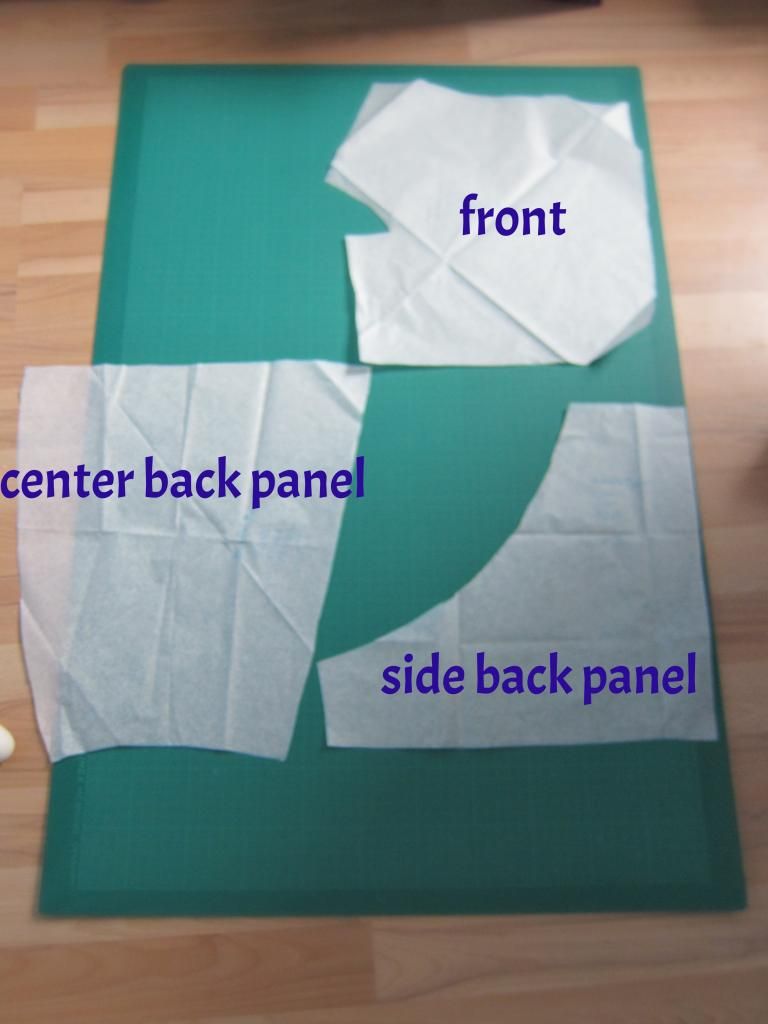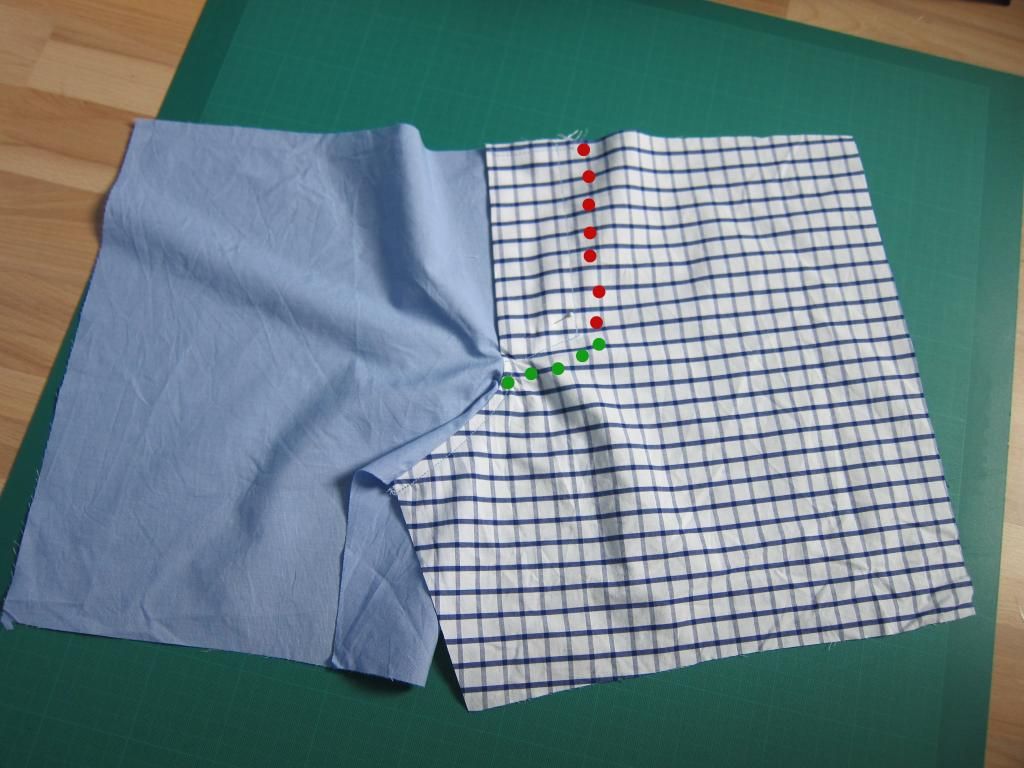Creating (& sewing) boxer shorts pattern from RTW
AKA, Replacing your husband's favorite boxers
This tutorial will cover drafting a pattern from a RTW pair of woven boxer shorts and then sewing a new pair based on your pattern. We will look at sewing both a pair of boxers with a center-back seam and one with a center-back panel.
The hardest part of this process may be getting the old boxer shorts away from your husband to use as a pattern template. Even if they are 10 years old with saggy elastic and holes and fraying edges, your husband may insist that those boxers are his favorites, and no, you can't have them to cut up. If this is the case, you may have to sneak your template pair of boxers out of the drawer when no one is looking or claim that the pair of boxers you intend to copy "is in the wash" or, even better, "was so old and full of holes, they just fell apart in the washing machine." I might also recommend performing the disassembly of the original pair of boxers when the owner of said boxers is not at home.
Ahem.
What you will need for this project:
* one old and worn out, but favorite-fitting pair of woven boxer shorts
* paper onto which you can trace a pattern (pattern paper, tissue paper, even newspaper works!)
* scissors
* pencil
* measuring tape
* fabric for new boxer shorts, 2/3 - 1 yd, depending on width of fabric and size of husband
* elastic for new boxer shorts
* matching thread for sewing, plus contrasty thread for topstitching, if desired
* pins
* sewing machine
OK, here is my husband's sad old pair of boxers, circa 2003:

Now I will remove the waistband and cut up the boxers, more or less along the seam lines.
This pair has a center-back panel, and here they are, all cut up:

Now I will measure the width of the waistband (these were 67cm unstretched) and throw it away.
The remaining pattern pieces need to be pressed flat and "traced." Just trace around the outside edge of each piece, being mindful of how much seam allowance you need or want. I give myself 1cm and sew, serge, then topstitch the seams. A lot of my husband's RTW boxers have flat-felled seams, which would require more of a seam allowance.
You also need to add a hem allowance to the lower leg edges and think about how you want to finish the waist. I favor a waistband with the elastic exposed on the inside (pictures later), and for this I only need to add the depth of the elastic + a seam allowance to the tops (waist edges) of the pattern pieces. If you prefer a casing, you will need to add double the width of the elastic + seam allowance to the tops of the pattern pieces.
Here are my finished pattern pieces:

(The center back panel should be symmetrical, so you can draft this pattern piece to cut on the fold, if desired.)
Now I will cut out the pieces of the new boxer shorts, being careful to hide the remains of the old ones deep in my scrap bag. For this project, I am using old dress shirts.
First we will look at sewing boxers with a center-back panel.
Two front pieces:

And the back pieces:

Once all the pieces are cut out, time to start sewing!
First, finish the long edges of the fly. I just serge my edges, but you could also sew a nice narrow hem. Then sew the fronts, right sides together, along the short (lower) edge of the fly, "around the corner," and down to the edge of what will become the inseam. Stitching shown by the red dots below. In this photo, you can see the finished raw edges of the fly, the two front pieces sewn together, and the seam has been finished (serged):

Next, you will need to press the fly 'overlap' pieces into place and topstitch the fly on left front. After pressing, I usually do this in two stages. First, working only with the left front piece (right front folded out of the way), sewing through the front and the folded-under fly facing, as indicated by the red dots. Then I remove the whole project from the machine, pin the right front fly (the 'underlap') in place, and sew the rest of the fly together (green dots). Then topstitch the rest of the front crotch seam.

It's helpful at this point to baste the top edges of the fly together.
The back pieces need to be sewn together, too!
Here are the front and back of the boxers:

(Note the center-back panel here ended up being too wide and I needed to cut it down... Not shown!)
Then the side seams and inseam are sewn:

Now the waist! I prefer to use boxer elastic and leave it exposed on the inside (uses less fabric!), so that's what I will show here. First I cut a piece of elastic 70cm long. The un-stretched measurement of my template pair was 67cm, but my elastic doesn't stretch as much as the RTW stuff, so I am giving the waist a few extra centimeters.
To make this exposed-on-the-inside style of waist, the top (raw) edge of the boxers needs to be pressed down about 1cm.
I sew the elastic into a loop, using a short and wide zig-zag stitch to join the ends. Then mark the elastic and the waist of the boxers into quarters.
Here you can see my loop of elastic, the folded and pressed top edge of the boxers, and both have been marked into quarters:

Match up the quarter points and sew the elastic to the inside of the waist, allowing the top edge of the elastic to cover the raw, folded edge of the boxers. Stretch the elastic to meet the waistband as you sew, but 1) don't stretch through the center back if you will add a tag there later, and 2) DO NOT stretch through the fly. Doing so will lead to unfortunate gaping issues.
Inside of finished waist:

Then hem the legs. Sometimes I press and sew a tidy narrow hem. Other times I just serge the edges to finish, press them up and sew them in place.
All done!

OK, now let's look at sewing boxers with a center-back seam. Just like the back-panel, version, you will need a ratty old pair of boxers to cut up and you will need to trace the cut-up pieces, being mindful of adding seam allowances, hem allowances, and enough 'height' at the top to finish the waist as you desire.
Here are my pattern pieces:

The fly edges should be finished and the front pieces sewn together. Here are the two front pieces (I have pressed the left front fly facing into place here to check it was wide enough):

And here they are with finished fly edges (green dots) and sewn together (red dots):

Then the fly needs to be topstitched. Here is the finished front:

And the finished front (left) with the finished back (right):

I finished the waist of this pair just as shown above.
Here are the finished boxers:

A helpful hint: If you are new to boxer-sewing and pattern-drafting, try to think of your first pair (or two or three!) are a prototype. You might not get it exactly right the first time. The first pair I sewed gaped at they fly. Horribly. So the next pair, I extended the fly by a centimeter when I was cutting and remembered not to stretch the elastic across the fly front. The pair shown here was my first pair of center-back-panel-style boxers, and my center-back panel was way too wide and I ended up needing the sew a seam down the middle to get rid of some of the width. For my next pair, I made sure the center-back panel was 1) actually symmetrical and 2) the appropriate width.
Once you get a good pattern going, sewing boxers is fast and easy!
Have fun!

Last edited by quartercentury; 09-30-2013 at 02:10 PM.
Expat Repatriating mama to two three!!!
To view links or images in signatures your post count must be 0 or greater. You currently have 0 posts.
New baby born at home, April 2014
(Disclaimer: He's bigger than that now)






















 Reply With Quote
Reply With Quote
Bookmarks